
Banishers: Ghosts of New Eden Review
While the team at Don't Nod may be more well known for their narrative games like the Life is Strange series, the French developer has openly embraced the potential of the action RPG genre, too, making it explicitly one of the studio's key strategic pillars for the foreseeable future. 2018's Vampyr was Don't Nod's first foray into role-playing games, and it was a "resounding success", in their words, having gone on to sell over 2 million units in its lifetime. Banishers: Ghosts of New Eden is then, essentially, the sophomore RPG follow-up nearly six years later.
The premise is an interesting one. Set in the late 17th century, two ghost hunter 'banishers' travel to the New World at the behest of a common colleague, seeking to quell a strange curse that has befallen the settlement of New Eden (hence the game's title). Antea Duarte is the accomplished and stoic master curse-lifter, while Red is her much-less-polished fledging apprentice. "I'm just the help", as he puts it.
But the source of the curse turns out to be something much more deadly than Antea or Red could have ever predicted: a powerful Nightmare that infests the dreams of local residents while also conjuring the undead in New Eden. Caught in its spectral trap, Antea is killed, and Red finds himself lost without his master, until he reunites with her undead spirit shortly afterward. Antea has become a ghost, the very thing she's spent her entire life fighting against.
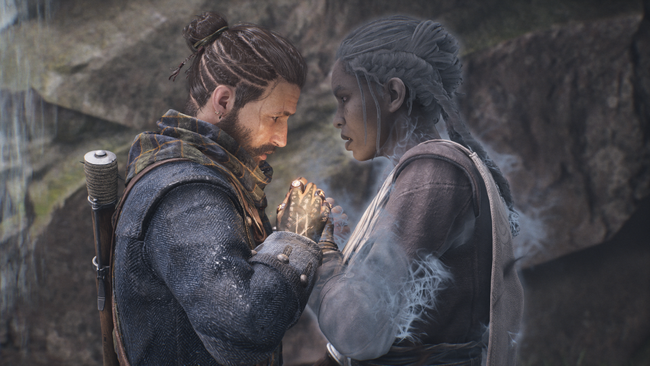
Antea and Red are not just master and student banishers. The pair are also lovers, and from the game's onset, it's clear there's a lengthy history between the two characters that the player is not immediately privy to. Red feels responsible for Antea's death, but the two must make a decision: do they take the lives of local townspeople in order to lead to Antea's resurrection, or do they let Antea pass on peacefully once they take care of New Eden's curse?
Banisher's biggest strengths lie most in its writing, characters, dialogue, & voice acting, which is perhaps not too surprising considering Don't Nod's pedigree. Antea and Red are complex and ultimately well-written characters themselves, and as you explore New Eden, you'll encounter numerous NPCs of the surrounding settlements. These characters are settlers, for the most part, coming to the New World in the hopes of a better life, with plenty of hardships both past and present.
As you interact with the people of New Eden, you'll encounter the game's sidequest-equivalent system, which are called Haunting Cases. Basically, Haunting Cases involve a living NPC and a dead NPC, and Red has to unravel who is being haunted and, more importantly, why they are being haunted. In order to do this, plainly, you'll have to speak with the settlers and learn about who they are and what they do. By their very nature, each Haunting Case almost always involves a pair of characters, or sometimes a trio (a single NPC can't haunt themselves, after all). The character relationships on display in these cases run a full & varied spectrum, from siblings, lovers, war buddies, colleagues, patients, rivals, and more besides.
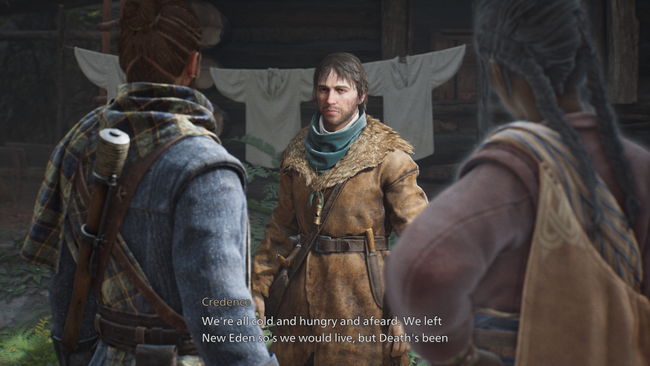
Thematically, the Haunting Cases are compelling. There's a strong personal focus on character relationships of all kinds; something where Vampyr also showed a similar strength. In Banishers, some of the Haunting Case outcomes are heartwarming while others are much more melancholic, and some outright tragic. Almost all the characters you meet are authentic, with believable problems and no easy solutions.
Several memorable characters come to mind, like two sisters with a strained relationship who run the nearby Hunter's Camp. There's also the veteran soldier who can't shake his past now working as a guard at the mountain outpost. There's the optimist nurse who maintains a cheery disposition even in the most torturous situations. The setting of New Eden is best built through its characters and their dialogue, and the variety of NPCs you meet throughout is genuinely a highlight of the game.
Mechanically, solving most Haunting Cases is simple, sometimes disappointingly so. You usually have to follow the marker to the quest area, and usually, you'll have to talk to another NPC or inspect a certain location, then move on to the next marker. More often than not, completing these cases boils down to repeatedly following the marker in a linear sequence of events. There is no real puzzle-solving or clue navigation here, as Red & Antea will mostly deliberate on the case themselves as you investigate the quest markers.
At the end of every Haunting Case, you'll have to make a choice. Do you Blame the living NPC for their actions, or do you Banish the ghost haunting them? The choices are admittedly a *little* bit more involved than that, but that's essentially what it comes down to. As you meet more NPCs and complete more Haunting Cases, the true nature of New Eden's Nightmare curse also slowly comes into focus throughout the game.
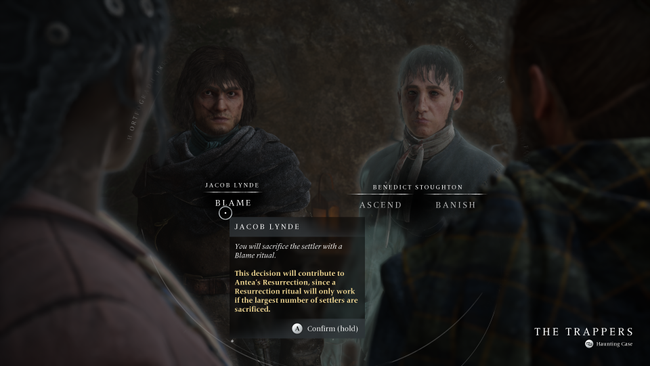
I have mixed feelings about this quest, choice, and consequence design employed here. The game explicitly tells you what each choice means regarding the ending of the game. Blaming the living NPCs is what you need to do if you are aiming for Antea's resurrection, while Banishing (or Ascending) dead NPCs leads to Antea's release. I have a feeling, depending on the player's desired outcome for Antea, that these Haunting Case choices will tend to become an all-or-nothing affair. If you decide you are going to resurrect Antea, you are going to Blame people regardless of who they are. Otherwise, you're not. You may not even pay much attention to the Case itself if you already know what you are going to do when you come to its conclusion. But perhaps exactly that is the game's intent, to show you the consequences of your decision regarding Antea on the people of New Eden. I give them credit for that.
In the limited amount of time I could dedicate to the game by myself in the review period, I can't claim to have fully unraveled how all the decisions made throughout the game lead to the various endings. According to Don't Nod, there are five endings to the game; not just the two outcomes for Antea. As you progress through Banishers, you'll have your Haunting Case outcomes as well as a promise made to Antea in-game about your decision on her revival. I assume the specific ending you achieve is some combination of those factors. I was able to get both obvious outcomes: Antea's resurrection and Antea's release, although there might be subtleties in the specific path I got to those endings that I am unaware of.
I won't spoil anything explicitly, but one thing I greatly appreciate about Banishers' overall narrative is that it stays relatively localized. Where I feel a lot of RPG stories continually escalate and escalate to eventually affect the status of nations or otherwise have world-altering stakes, Banishers remains low-key in comparison. It's difficult to say more in detail without saying too much, but the unraveling of New Eden's curse is simultaneously appealing and constrained. Amaka Okafor & Russ Bain's portrayals of Antea & Red are also excellent throughout.
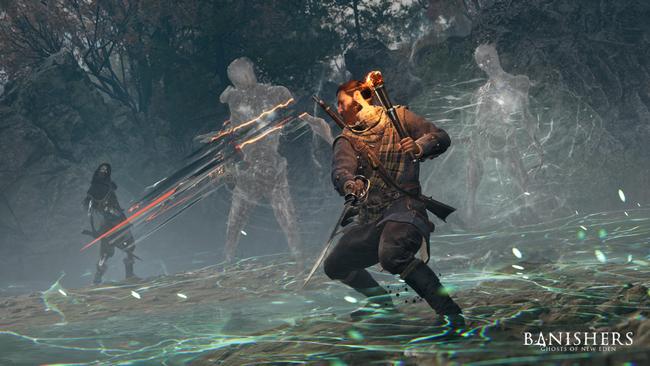
Quests and endings aside, as I started to become acquainted with Banisher's overall game flow and structure, I found myself a little bit disappointed. One of the aspects I like most about Vampyr was the game's unique NPC and dialogue systems, and how they synergized well with the game's experience points, skill systems, and even the vampire theming. The city was relatively tight, and the whole game had a unique style tailored to it that not many games exhibited. It wasn't just a usual 'exploration and battles' RPG design.
Banishers feels much more typical in comparison. You'll go through much larger explorable zones, each with a literal checklist of things to find and 'points of interest' to uncover on the map. In the game, you'll explore four separate regions of the game world. It's not quite 'open-zone', but you still have plenty of collectibles to find and battle trials to clear. You'll find keys to unlock chests, treasure maps to consumable resources, and the like. Sure, there's always a sort of base satisfaction to filling out your checklist and 'clearing' the map of icons, but it's mostly busywork moreso than anything actually compelling.
Combat in Banishers is adequate at best and unexciting at worst. There's a sort of rhythm to it, where you toggle between Red and Antea in a pattern to link together attacks in combo chains. I won't get into all the minute details here, but you are incentivized to regularly toggle between the two characters as you take on the spectral foes haunting New Eden. At first, I felt this sort of dual-character pairing could be enough of a wrinkle to keep things engaging, but that didn't turn out to be the case. While not inherently broken, movements and attacks always felt a little stiff to me. I wish you could pull the camera back a little bit, too.
Banishers desperately needs better enemy variety, as you'll spend the vast majority of the game's 30-40 hour runtime fighting the same small set of foes. You have normal specters, fast specters, and shooty specters. Then you have big 'alpha' versions of each of those three. Then you have armored versions of each of those three. Then you have giant specters. Then you have wolves, big wolves, and armored wolves. Sometimes the armored specters have slightly different weapon types - like a scythe or sword - but you fight them in essentially the same way. Once you learn the basic tactics to how to fight these foes, fighting them honestly becomes kind of boring, with nothing new to spice things up.
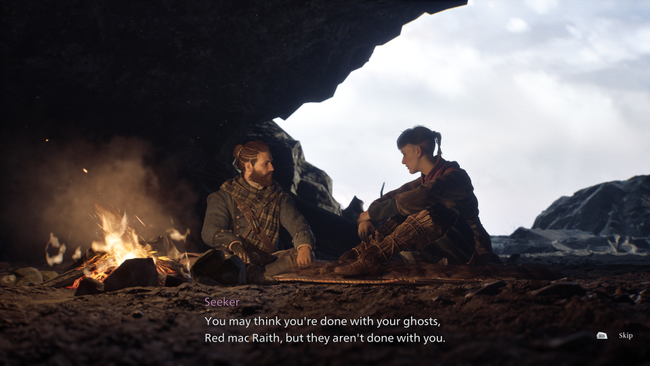
Banishers also commits what I would call one of my personal 'cardinal sins' of RPG combat design, that is, boss encounters that summon squads of underling mooks to fight for them. Not all the bosses in the game do this, sure, but several bosses will have phases where Red will need to clear a wave of more typical specters before being able to land hits on the boss themselves.
I've always felt relying on this sort of underling-reliant boss-fight structure is a failure in design, in most cases. It's as if the developers designed a combat system, but didn't know how to design a boss fight, so bosses are largely just disguised regular combat instead. Not only that, but a few of the bosses themselves are just bigger versions of regular enemies, more or less, which is never all too interesting.
What's most disappointing of all of this is that stiff combat, poor enemy variety, and even this 'mook-squad' boss design were all shortcomings present in Vampyr too (Kyle even touches on these things from his review at the time), which makes it even more disappointing that Banishers falls short in the same areas 6 years later.
Banishers feels like a more polished, bigger budget, but less interesting RPG than Vampyr. I have to imagine it has to be Don't Nod's most expensive game, and character models, environments, and cinematic animations all look great. But combing the world for too many materials with uninspiring combat makes it feel more ordinary, in ways. Put plainly, the role-playing mechanics of Banishers are easily where it struggles most.
I come away from Banishers: Ghosts of New Eden endeared to its characters and storytelling, but disappointed in the game's world structure and combat. Antea and Red are captivating characters, and I applaud the game's narrative style & direction, but mundane world exploration, tedious combat, and average questing pull down a game that I had higher hopes for.